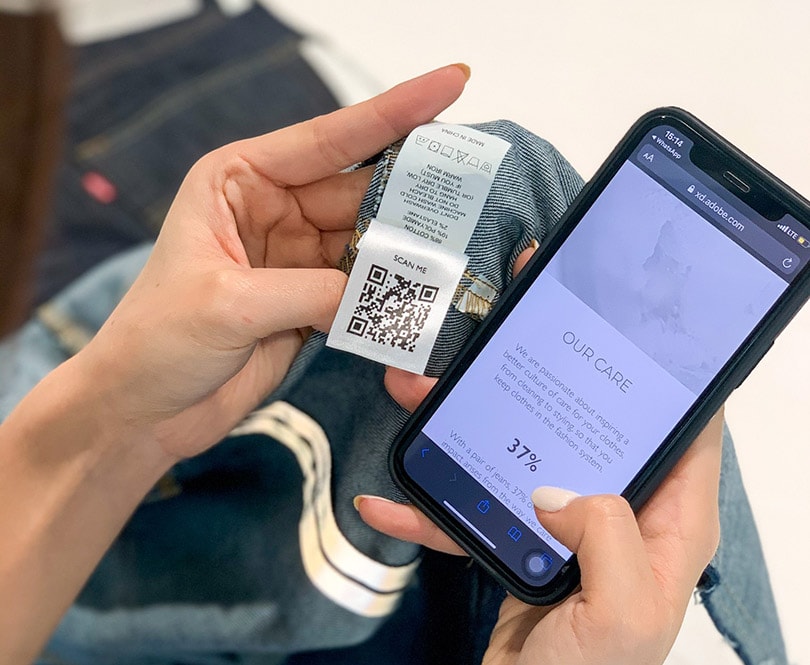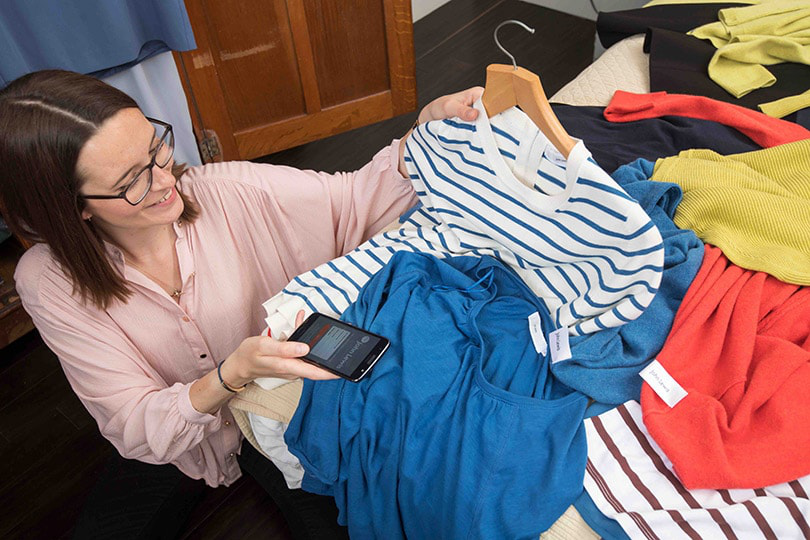The future of garment technology in circular fashion

‘Technology’ in fashion is a wide-reaching term, one that covers anything from product data and traceability, to logistics, inventory management and garment labels. As an umbrella term, technology covers all of these topics and is an increasingly pivotal enabler of circular business models. But when we talk about technology we are no longer talking only about garments being tracked from suppliers to retail stores in order to measure how many garments are sold, nor are we talking only traditional stitch-on garment tags which display country of origin and (often unreliable) information on a product’s material composition. Instead, it’s time to spotlight the rise of ‘digital triggers’ in facilitating circular fashion models.
By Chris Lijzenga (Circle Economy) in collaboration with partners at Avery Dennison, CaaStle, The Renewal Workshop, and Adidas.
In circular resale and rental business models, brands and solution providers need to account for sold garments coming back into their possession, so that they can be repaired, reused or recycled. To facilitate this second, third and fourth life, each individual garment would benefit from an unique identification code and inbuilt lifecycle tracking. In rental, each garment needs to be tracked along its journey from the customer to repair or cleaning, back into the rentable inventory, and back out to the next customer. In resale, third-party platforms need to know exactly what kind of used garment they have in their possession, including, for instance, original sales and marketing data, which can help to verify whether it’s authentic and inform how to price it’s resale for future customers. Enter: digital triggers.

What are the options
A digital trigger connects a consumer with data contained in a software platform. The kind of data that a consumer can access is controlled by the brand and service provider and could be specific garment information—such as its care instructions and fibre content—or allow the consumer to engage with the brand regarding their purchase— by directing them to a digital marketing campaign about the garment’s production, for example. Currently, the most recognizable and common way to include a digital trigger in a garment is to add a QR code to a care label or a QR code to a separate companion label that states ‘scan me’. Most consumers today are aware they can scan a QR code with their smartphone, although QR code adoption rates vary widely by region. Asia leads in adoption rates, while Europe lags far behind.
The challenge is keeping the QR code on the garment for its entire life, as care labels are often cut off by consumers. Yes reader, you too! We’ve all done it before. And no label means no data. To mitigate this risk, brands can add a QR code to a sewn-in woven label or embed a label via a heat transfer, thus ensuring that the QR code cannot be cut out of the garment. That said, having a QR code woven into the fabric itself does not make it as obvious to the consumer that the QR code is associated with care and content information, making it less likely that they would be drawn to scanning it for the intended purpose.
A second is an NFC (Near Field Communication) tag embedded in a woven label, which is extremely unlikely to be removed. However, the garment maker then needs to make it very obvious to a consumer that it is present in the woven label and there needs to be an awareness of how to download an NFC reader on their smartphone. Some smartphones, especially those released in the past few years, have NFC chips built into the hardware, but not all phones do, and this means many consumers need to download a dedicated NFC reader from the app store.
The final type of digital trigger that can be applied is an RFID (radio-frequency identification) tag, but RFID tags are generally not customer-facing. Instead, they are used on hang tags or packaging to track products through their life cycles of production and warehousing, through to the customer, and back to the retailer for repair or resale. RFID tags require a dedicated reader, and this limitation means that consumers aren’t able to scan them, meaning consumer-facing information must be accessible elsewhere. RFID tags, therefore, are useful for solution providers and back-end processes as they facilitate traceability throughout the lifecycle chain. A further complication for their application is that RFID tags often do not meet wash standards, which is less than ideal for circular apparel models for the apparel industry, where readability over time is essential.
How should a brand decide/

Brands consider multiple factors in their decision to implement digital tech solutions, including the future of their products, future legislation, engagement with consumers through the life of a product and the garment’s environmental impact. They also want their customers to lengthen the lifespan of their garments by recycling, repairing or reusing it. Through the smart use of digital triggers and labels, brands are also better able to understand the needs of their customers.
For example, by tracking garments along the multiple stages of their lifecycle, brands can know when repairs are needed or when to direct consumers to have the garment recycled. Digital labels can also be a more aesthetic and practical option, as physical care labels are often cut off due to discomfort or being visually unattractive, while a digital trigger can remain on a product for longer by being placed directly on the garment. Typically, brands reviewing the digital trigger product options (NFC, RFID, QR or other) will review the easiest and most cost-efficient way to add a digital trigger on to their existing product, without compromising the ability of that digital trigger to remain on the product for its entire lifespan.
The choice of technology also depends on what they aim to achieve. If a brand wants to present customers with more information about the journey of the garment or give them options on how to engage with circularity or recycling, they will need to implement a digital trigger like QR or NFC because RFID isn’t scannable by customers. However, if a brand wants to conduct efficient in-house or outsourced inventory management and track assets throughout the repair and cleaning services for a rental model, a washable RFID makes a lot of sense.
The far-reaching potential of digital tagging
Currently, physical care labels are still a legal requirement but increasingly, country-specific legislation is trending towards allowing care and content information to be delivered digitally. As customers demand more transparency around their products, the first step is that digital triggers are expected to increasingly show up as an add-on to physical care labels, rather than a replacement. This dual-approach is more accessible for brands, less disruptive, and allows for additional information to be stored about the product and for further engagement with re-commerce, rental or recycling models. In practice, this means that for the foreseeable future physical tags will continue to use the country of origin and material composition, but either on the same or add-on tag, or embedded directly into the fabric itself, will be a scannable trigger.
These digital triggers allow for new levels of transparency, as brands can show the supply chain journey of the garments and clothes can be validated for authenticity. In addition, by allowing consumers to scan items into a digital wardrobe, brands can also create new revenue channels on digital platforms by facilitating consumers to resell their own used clothing. Finally, digital triggers can enable re-commerce or rental by, for example, showing consumers where their nearest suitable recycling station is.







